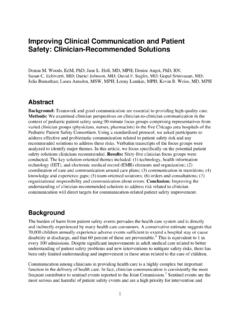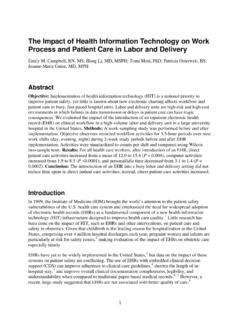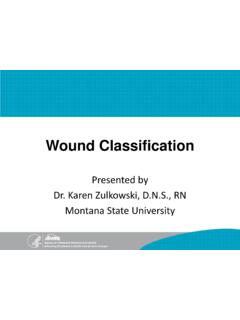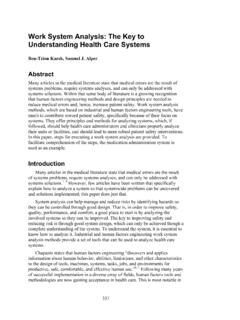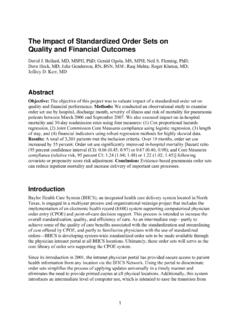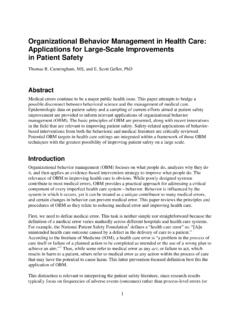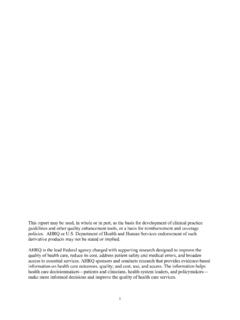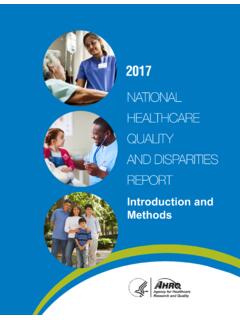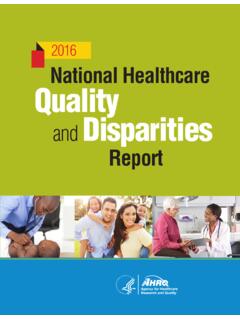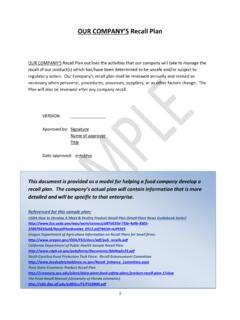Transcription of Hospital Guide to Reducing Medicaid Readmissions: Toolbox
1 Hospital Guide to Reducing Medicaid ReadmissionsToolboxHospital Guide to Reducing Medicaid Readmissions ITable of ContentsIntroduction to the Tools ..1 Tool 1: readmission Data 2: readmission Review ..6 Tool 3: Data Analysis Synthesis Tool ..9 Tool 4: Hospital Inventory Tool ..13 Tool 5: Cross-Continuum Team Inventory Tool ..14 Tool 6: Conditions of Participation Checklist Tool ..16 Tool 7: Portfolio Design ..17 Tool 8: readmission Reduction Impact and Financial Analysis Tool ..20 Tool 9: readmission Risk ..22 Tool 10: Whole-Person Assessment ..24 Tool 11: Discharge Information Checklist ..28 Tool 12: Forming a Cross-Continuum Team ..29 Tool 13: Community Resource Guide .
2 34 Hospital Guide to Reducing Medicaid Readmissions 1 Hospital Guide to Reducing Medicaid ReadmissionsIntroduction to the ToolsThis package of tools accompanies the Hospital Guide to Reducing Medicaid Readmissions, which offers indepth information about the unique factors driving Medicaid readmissions and a step-by-step process for designing a locally relevant portfolio of strategies to reduce Medicaid readmissions. Some of the tools are adaptations of best-practice approaches to make them more relevant to the Medicaid population; many tools were newly developed through this project. This introduction offers an overview of the tools available in the package by briefly describing what they contain, who should use them, and how much time they take to in Section 1: Know Your DataKnowing where to start in Reducing Medicaid readmissions, including whether your team needs to adapt or expand your efforts to best serve Medicaid patients, requires you to understand your Hospital s current readmission patterns.
3 These tools will assist you in collecting quantitative and qualitative data on your Hospital patients and interpreting those 1 ToolsDescriptionStaffTime RequiredTool 1 Data Analysis ToolThis tool is a 10-point analysis of data to facilitate a compare and contrast view of readmissions by payer to identify differences between Medicare, Medicaid , commercial, and all-payer analyst, business analyst, staff able to run administrative data 4-6 hoursTool 2 readmission Review ToolAdapted from the STAAR* approach, this one-page interview Guide prompts clinical or quality staff to elicit the patient, caregiver, and provider perspective about the causes of improvement, nursing, case management staff30 minutes/review.
4 10-20 interviews suggested to startTool 3 Data Analysis Synthesis ToolThis template is used to create a narrative to describe the results from the quantitative data and readmission improvement staff2 hours**The State Action on Avoidable Rehospitalizations Initiative of the Institute for Healthcare Hospital Guide to Reducing Medicaid ReadmissionsTools in Section 2: Inventory readmission Reduction EffortsBefore planning how to address Medicaid readmissions, it helps to understand what is currently being done to improve care transitions, increase patient education, and reduce readmissions, as well as other interrelated improvement efforts across a complex organization.
5 The tools in Section 2 will help you take inventory of your Hospital s readmission reduction efforts across departments, assess your current discharge process, and inventory the resources and supports your community partners offer that can help reduce avoidable readmissions. By gathering all this information in one place, your team can evaluate how well these efforts align with your Medicaid patients needs, what redundancies can be streamlined, and what gaps still need to be 2 ToolsDescriptionStaffTime RequiredTool 4 Hospital Inventory ToolThis tool prompts a comprehensive inventory of readmission reduction activity across departments, service lines, and units within the improvement, readmission reduction team members2-4 hoursTool 5 Cross-Continuum Team Inventory ToolThis tool prompts a comprehensive inventory of community-based providers and agencies that provide services helpful in the postdischarge improvement leadership.
6 Cross-continuum team4-5 hoursTool 6 Conditions of Participation Checklist ToolThis one-page tool, adapted from the CMS Conditions of Participation surveyor guidance, prompts consideration of whether a set of standardized improvements are being provided to all patients, regardless of risk. Quality improvement, nursing, case management staff2 hoursTools in Section 3: Develop a Portfolio of StrategiesSection 3 of the Guide walks through the process of developing a portfolio of strategies to reduce Medicaid readmissions, including how to specify your objective and aims, select the most effective set of strategies, and quantify the expected impact of those strategies.
7 The tools in Section 3 assist with designing a portfolio, as well as calculating the financial and clinical impact of your readmission reduction 3 ToolsDescriptionStaffTime RequiredTool 7 Portfolio Design ToolThis tool prompts readmission reduction teams to expand readmission reduction efforts to include action in at least three broad domains: improve standard care for Medicaid patients, collaborate with partners, and provide enhanced services for high-risk reduction champion, readmission team2-4 hourscontinuedHospital Guide to Reducing Medicaid Readmissions 3 Section 3 ToolsDescriptionStaffTime RequiredTool 8 readmission Reduction Impact and Financial Analysis ToolThis Excel sheet helps you model the impact of the strategies in your Hospital s readmission reduction portfolio.
8 It prompts teams to quantify which patients will be served by each strategy, what their baseline readmission rate is, and what the projected readmission reduction will be. It also helps estimate the avoided utilization (payer cost) due to each of the strategies, accounts for the investment cost of the intervention (in tools, staff, time), and calculates net savings (to payers).Quality improvement leadership, business analyst2-4 hoursTools in Section 4: Improve Hospital -Based Transitional Care Processes for Medicaid PatientsThere are many best practice recommendations from such packages as BOOST, STAAR, and Section 4 of the Guide discusses how to adapt these best practices to best serve Medicaid patients needs.
9 This section offers three new tools pertinent to Medicaid readmissions: a readmission risk tool, a whole-person assessment tool that takes into account social determinants of health, and a checklist of information that should be communicated between providers, based on the Centers for Medicare & Medicaid Services (CMS) Conditions of 4 ToolsDescriptionStaffTime RequiredTool 9 readmission Risk ToolThis tool is an educational and awareness-building tool for frontline staff, cross-continuum teams, and quality improvement leadership to quickly review the many factors that lead to risk of readmission . It highlights the fact that narrow targeting strategies will miss most readmission , nursing, case management, cross-continuum teamsQuick review and discussion at meeting; post in workroomsTool 10 Whole-Person Assessment ToolThis tool provides a checklist to prompt frontline staff to identify and address basic staff in the Hospital , including social workers, case managers, minutes to assess.
10 Conduct at least 24 hours before discharge for sufficient time to act on information and make referralsTool11 Discharge Information ChecklistThis tool, adapted from the CMS Conditions of Participation, provides a checklist of information that needs to be provided to patients and their receiving providers at the time of improvement, nursing, case managers, hospitalistsN/A; tool used for informing how to convene this team of variable sizeiBOOST = Better Outcomes for Older Adults Through safe Transitions, STAAR = State Action on Avoidable Rehospitalizations Initiative, RED = Re-Engineered Hospital Guide to Reducing Medicaid ReadmissionsTools in Section 5: Collaborate With Cross-Setting PartnersForming partnerships with receiving providers clinical and social not only helps ensure that the clinical and transitional care hospitals provide is more likely to succeed in the posthospital setting, but also extends and deepens the resources and services available to patients.

